South Carolina, known for its warm sunshine and gentle breezes, is also home to some truly stunning flowering trees. As the seasons change, these trees dress up in radiant flowers, painting the state in a variety of beautiful colors.
For those considering adding a dash of floral charm to their yards or simply curious about the region’s natural beauty, this guide is for you. In this article, we’ll introduce you to a selection of breathtaking trees that flourish in the Palmetto State, turning any spot into a picturesque scene.
South Carolina USDA Hardiness Zones
A hardiness zone tells you which plants can thrive in your area based on the average minimum winter temperature. It’s like a guideline to choose plants that won’t die during the coldest days.
Predominantly, South Carolina falls within Zone 7 to 9, which is further split into a and b, with b being the warmer of the two. These zones indicate the average annual minimum temperatures the region experiences. Here’s a breakdown:
- Zone 7a: Minimum temperatures of 0°F to 5°F. Found in the northwestern part of the state.
- Zone 7b: Minimum temperatures of 5°F to 10°F. Covers the central and slightly western areas.
- Zone 8a: Minimum temperatures of 10°F to 15°F. Encompasses much of the central part.
- Zone 8b: Minimum temperatures of 15°F to 20°F. Common in the southeast.
- Zone 9a: Minimum temperatures of 20°F to 25°F. Found in the far southern tip.
Remember, choosing the right tree for your hardiness zone will help ensure a beautiful bloom and a healthy garden for years to come. Now, without further ado, let’s dive into the 13 gorgeous flowering trees that thrive in South Carolina!
1. Leatherleaf Acacia (Acacia craspedocarpa)
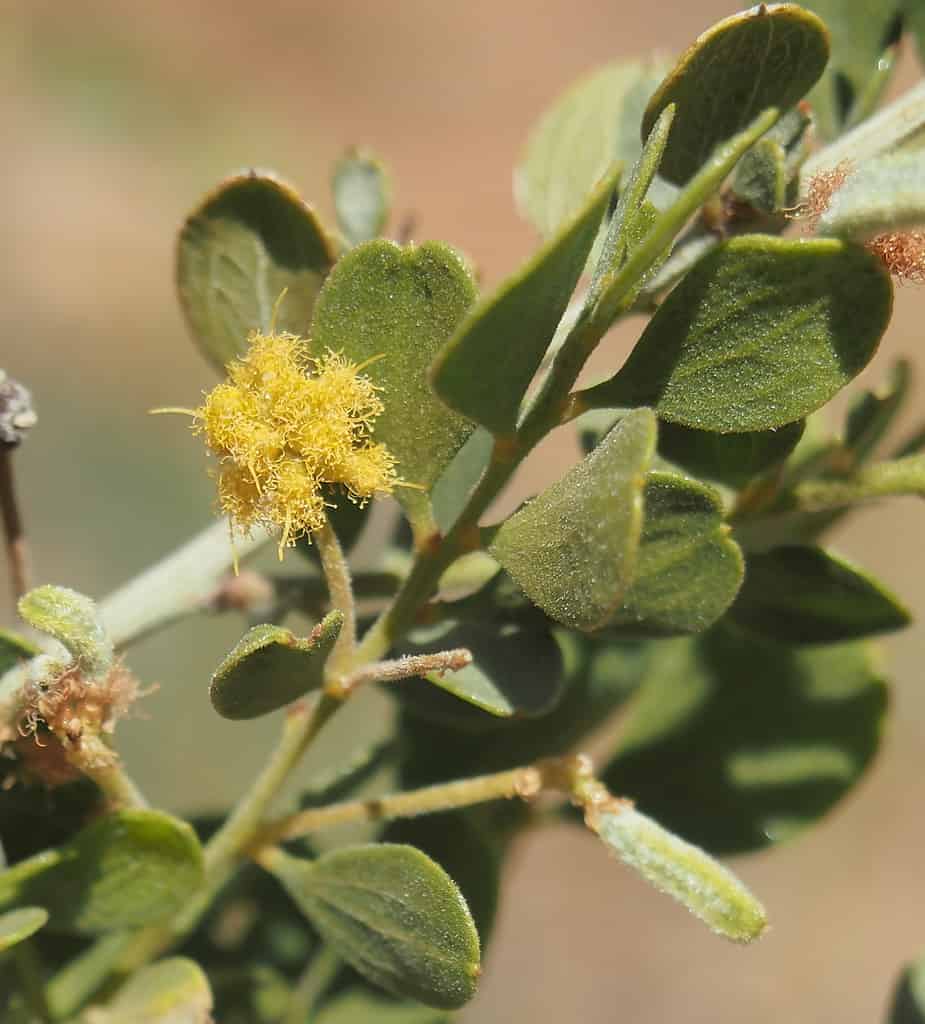
An Australian native, the leatherleaf acacia has yellow flowers.
The leatherleaf acacia boasts a rugged beauty with its dense, multi-trunked structure and bluish-green, silvery leaves that feel as tough as leather. During spring, it’s adorned with yellow flowers that have a magnetic pull on bees, though you might spot some flowers even till fall.
This native of Western Australia stands out for its resilience. It’s impressively drought-resistant once it’s settled in, can endure scorching temperatures, and is unfazed by cold down to 16°F. Plus, it’s a low-maintenance choice. Given its toughness, it’s ideal for creating natural barriers or screens in gardens.
Expect the leatherleaf acacia to reach heights of 12 to 15 feet, spreading as much in width. In a year, it can grow by about 12 inches. However, its growth spurt and final stature can be influenced by how much you water it. Ideally, find it a sunny spot and plant it in moderately rich soil that drains well, with a pH ranging from slightly acidic to quite alkaline.
2. Coral Bark Maple (Acer palmatum ‘Sango-kaku’)
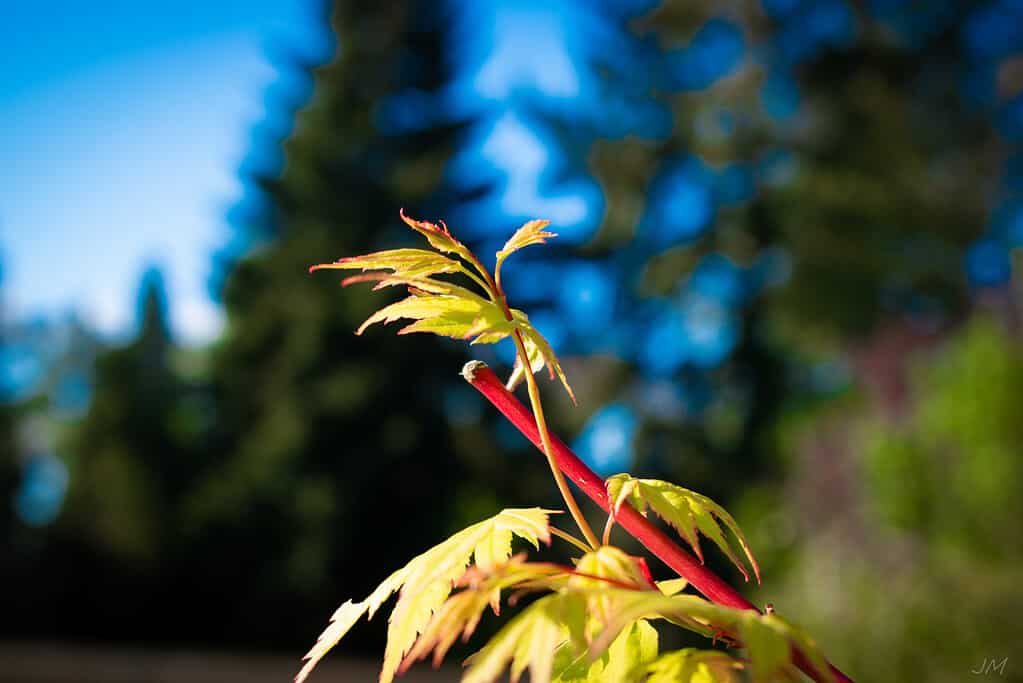
As its name suggests, the coral bark maple has a coral-red bark.
©Jessica Middleton/ via Getty Images
The coral bark maple, a type of Japanese maple, is a deciduous tree known for its delicate five-lobed leaves. These leaves start as a vibrant yellow-green in the spring, transition to a deeper green in summer, and finally take on shades of gold, yellow, and red in the fall. As they drop, they reveal the tree’s standout feature: the bright coral-red bark of its younger twigs and branches, giving a lively touch to the otherwise muted winter scenery.
While the tree does sport small reddish flowers in spring, they’re subtle rather than flashy.
This slow-grower stands with an elegant, upright, vase-like shape, proving its worth all year round. Anticipate the coral bark maple growing to a height of 20 to 25 feet and spreading about 15 to 20 feet wide. For the best results, place it in a spot with either full sunlight or partial shade and ensure the soil is moist, rich in organic matter, slightly acidic, and has good drainage.
3. Strawberry Tree (Arbutus unedo)
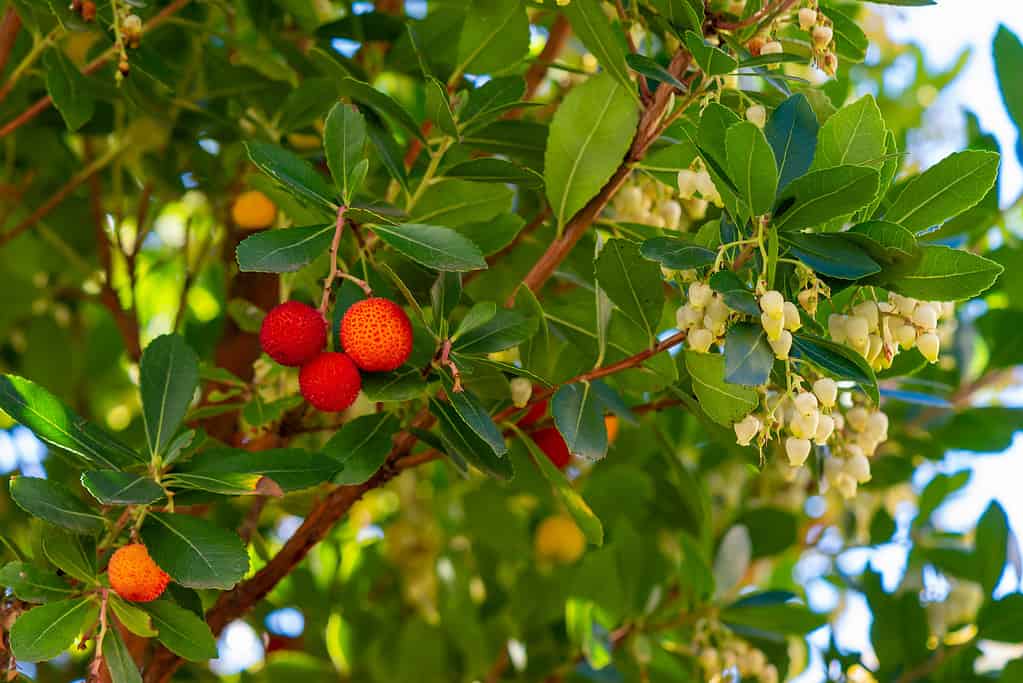
The strawberry tree has strawberry-like berries and white flowers.
©HJBC/ via Getty Images
Originating from the Mediterranean Basin and Western Europe, the strawberry tree is famous for its arbutus berry. These berries look a bit like strawberries, leading to its popular name. The strawberry tree is a small tree with year-round visual appeal, making it a top pick for South Carolina gardens. Between fall and mid-winter, it sports fragrant, white, bell-like flowers that dangle gracefully from the ends of its branches.
Bees play a role in pollinating these flowers, leading to the formation of round, 1-inch fruits in the winter. These berries shift from green to yellow and finally to red over a year. Interestingly, as the older berries ripen, the tree sprouts a new batch of captivating white flowers. Though these berries can be eaten and are mildly sweet, their taste is typically mild, and their texture is a bit grainy.
As the tree ages, its form can become twisted and gnarly, adding to its unique character and charm.
Expect a slow to moderate growth rate from this tree. While it naturally grows with multiple stems, it can be cultivated to have a single trunk and reach between 6 and 15 feet in height. The strawberry tree thrives best in average, acidic, and moist soils and can flourish under both full sunlight and partial shade conditions.
4. Eastern Redbud (Cercis canadensis)
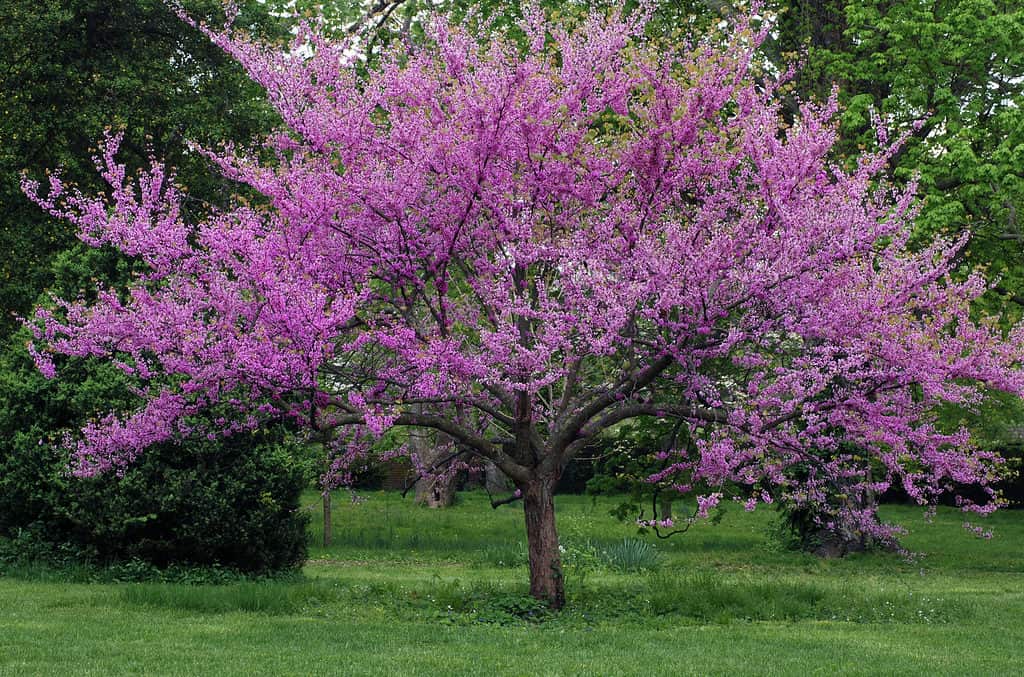
A beautiful flowering tree to grow in South Carolina, the eastern redbud haws rosy-pink blooms.
©Marie C Fields/Shutterstock.com
The eastern redbud is a deciduous tree, often branching out from multiple trunks, that boasts a rounded crown and branches that spread out in layered tiers. In spring, its bare limbs are adorned with rose-pink flowers that resemble peas, presenting a spectacular sight before the leaves make their appearance.
These blooms are a treat for honeybees who gather pollen from them. Butterflies and hummingbirds are also drawn to the eastern redbud for its nectar. It’s not just its beauty that makes it notable; it’s also the state tree of Oklahoma and plays a vital role as an early pollinator-friendly plant.
Standing tall at 20 to 30 feet, the eastern redbud is versatile, growing in both dry and moist areas. However, it truly thrives in sun-drenched spots with well-draining soil, though it can also manage in partially shaded areas.
5. Cornelian Cherry (Cornus mas)

Beautiful throughout the seasons, the cornelian cherry is an award-winning flowering tree.
©iStock.com/RuudMorijn
The cornelian cherry is a versatile tree, a star across multiple seasons. As winter wanes and spring arrives, clusters of tiny, radiant yellow flowers burst forth on its bare limbs, offering a cheerful display for weeks. Once the flowers have had their moment, shiny red fruits resembling cherries take center stage in the heart of summer.
This tree, with a bushy demeanor, flaunts oval-shaped dark green leaves that shift to a deep purple in the fall months. As they depart for the winter, they reveal the tree’s intriguing rough bark with a rich brown hue.
It’s a recipient of the Cary Award and The Pennsylvania Horticultural Society’s Gold Medal, signifying its excellence in resilience, aesthetics, and resistance to pests. Especially noteworthy for New England gardens, this tree stands tall at 15 to 25 feet and spreads around 12 to 20 feet.
For planting, a spot with full sunlight or a bit of shade works best. The soil should be of average fertility, retain some moisture, and ensure proper drainage.
6. Island Tree Poppy (Dendromecon harfordii)
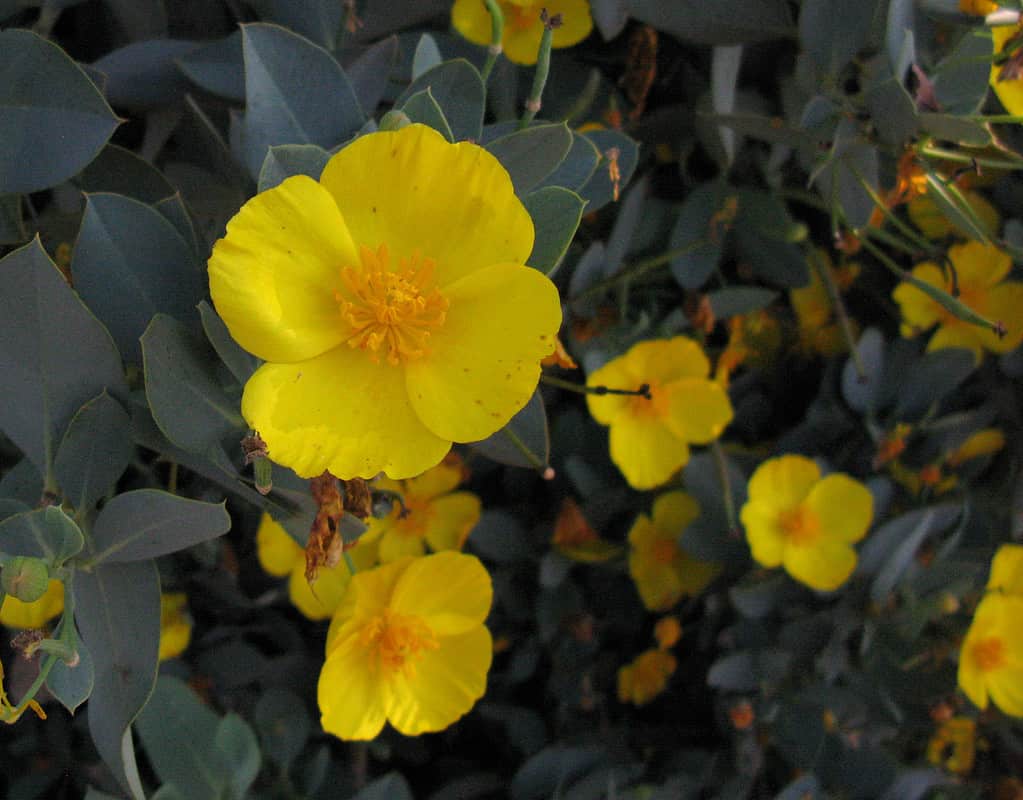
A small tree with yellow flowers, the island tree poppy is native to California.
©Kelli Kallenborn/ via Getty Images
The island tree poppy is a striking small tree adorned with oval, blue-green leaves that measure about 3 inches in length. During spring and into summer, it’s decorated with yellow flowers, each about 3 inches wide. What’s more, you can spot occasional flowers on it year-round.
Native to California, it is not only a visual treat but also a practical choice. It’s easy to nurture, largely free from pest troubles, and thrives in coastal environments. Among its best attributes is its consistent flowering throughout the year. Whether as a divider or a standout feature in a garden, it blends seamlessly, especially in Mediterranean-themed landscapes.
Typically, it reaches a height and width between 8 and 20 feet.
For those considering planting it, a sunny spot is ideal. However, it’s pretty accommodating when it comes to soil, doing well in everything from well-draining soil to clay and sand. Plus, it can also thrive in partially shaded areas that are on the drier side.
7. California Flannelbush (Fremontodendron californicum)

Another Californian flowering tree you can grow in South Carolina is the California flannelbush.
©Sundry Photography/ via Getty Images
The California flannelbush is a rapidly growing evergreen plant that can take the form of a sprawling shrub or a small tree. It dazzles onlookers with its abundant, radiant yellow flowers that grace its branches from late spring to early summer. These sizable, dish-like flowers, around 3 inches wide, consist of 5 striking sepals that gradually adopt a hint of orange as they age. After the flowering season, these blooms give way to distinctive seed pods with a fuzzy, rust-hued covering.
It’s worth noting that direct contact with these fuzzy hairs can cause skin or eye irritation. Because of this, it’s a good idea to plant the California flannelbush away from frequented areas like patios and walkways.
In terms of size, expect this flowering tree to reach between 8 and 18 feet in height and spread out 6 to 10 feet.
For those aiming for the best growth and bloom, a sunny location paired with gravelly or moderately fertile, fast-draining soil will serve this tree well.
8. Chinese Witch Hazel (Hamamelis mollis)
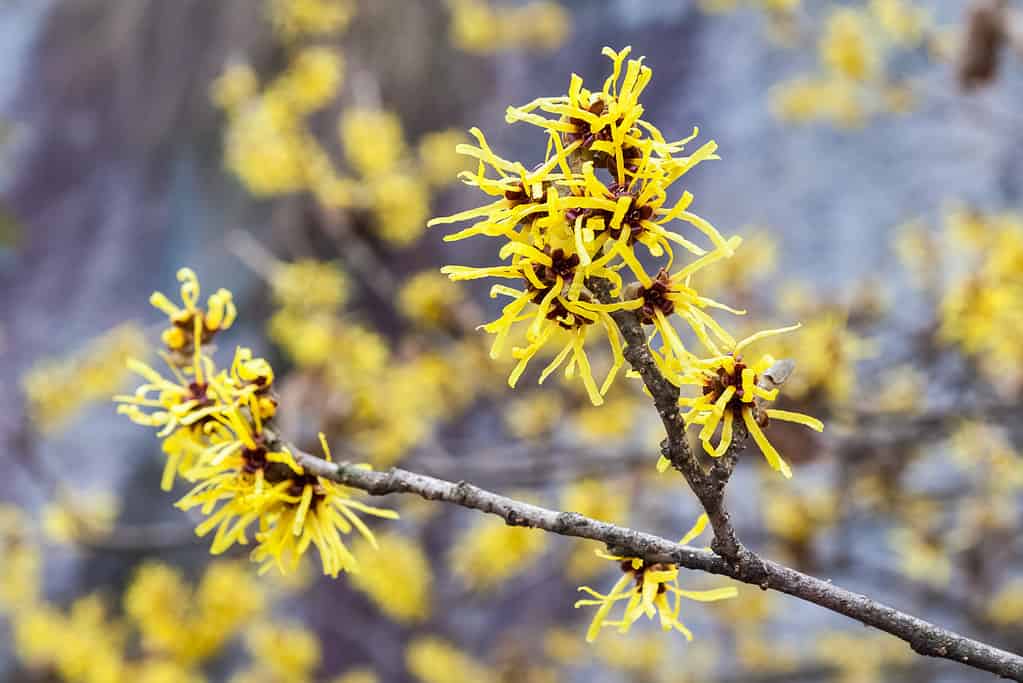
The Chinese witch hazel boasts fragrant, yellow blooms.
©chuyu/ via Getty Images
Originating from China, the Chinese witch hazel is a captivating flowering tree that showcases golden-yellow blooms with a rich fragrance during the later winter months. These unique flowers feature four ribbon-esque, crumpled petals that resemble gold straps.
Interestingly, on warmer days, the flower petals stretch out, resembling spider legs. Yet, during chillier times, these petals tend to curl inward to shield themselves from the cold. The tree’s branches, with their near-black bark, support broad, green leaves that feel soft on their underside. In the fall months, these leaves transform into appealing shades of yellow.
In terms of size, the Chinese witch hazel can reach a height and breadth of 10 to 15 feet.
For those planning to plant this flowering tree in South Carolina, a location that receives full sun to partial shade is ideal. Pair that with soil that’s moderately moist and drains well for optimum growth.
9. Chinese Flame Tree (Koelreuteria bipinnata)
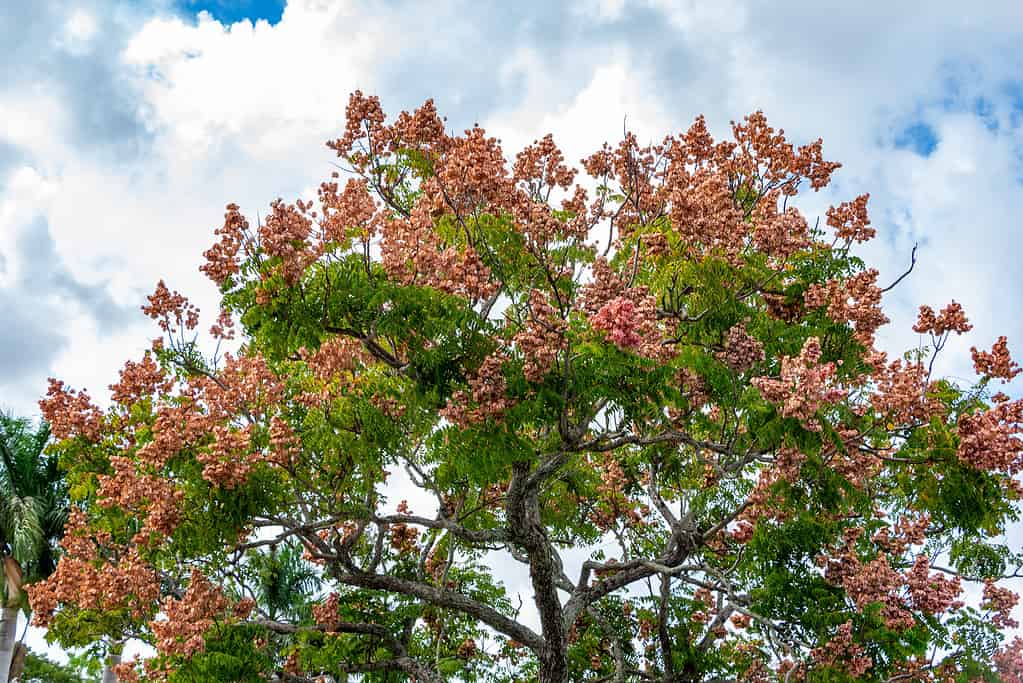
The Chinese flame tree boasts deep green leaves, yellow blooms, and pink seed capsules.
©Sunshower Shots/ via Getty Images
Another flowering tree from China, the Chinese flame tree is a charming, small deciduous tree known for its refined vase-like silhouette that eventually broadens at the top. It boasts shiny, deep green leaves that can span from 12 to 24 inches in length. As the fall months approach, these leaves transform into a vivid golden-yellow hue before gracefully falling off.
During summer, this tree truly shines, erupting in vibrant yellow blossoms that gather in large clusters at the branch tips. These blooms linger for weeks, offering a dazzling floral show. Once the flowers fade, they make way for intriguing, lantern-shaped seed capsules that dangle from the branches. Shifting from pink to a rosy hue, these capsules last for up to five weeks. Even when dried, they maintain their lovely pink shade, making them a favorite for crafting lasting flower displays.
With its abundant, eye-catching blooms, striking leaves, autumnal hues, decorative fruits, and resilience against drought, the Chinese flame tree is a treasured addition to South Carolina landscapes. Expect this tree to reach impressive heights and widths of 30 to 40 feet.
A sunny spot paired with moderately moist and well-draining soil will ensure it thrives.
10. Bay Laurel (Laurus nobilis)
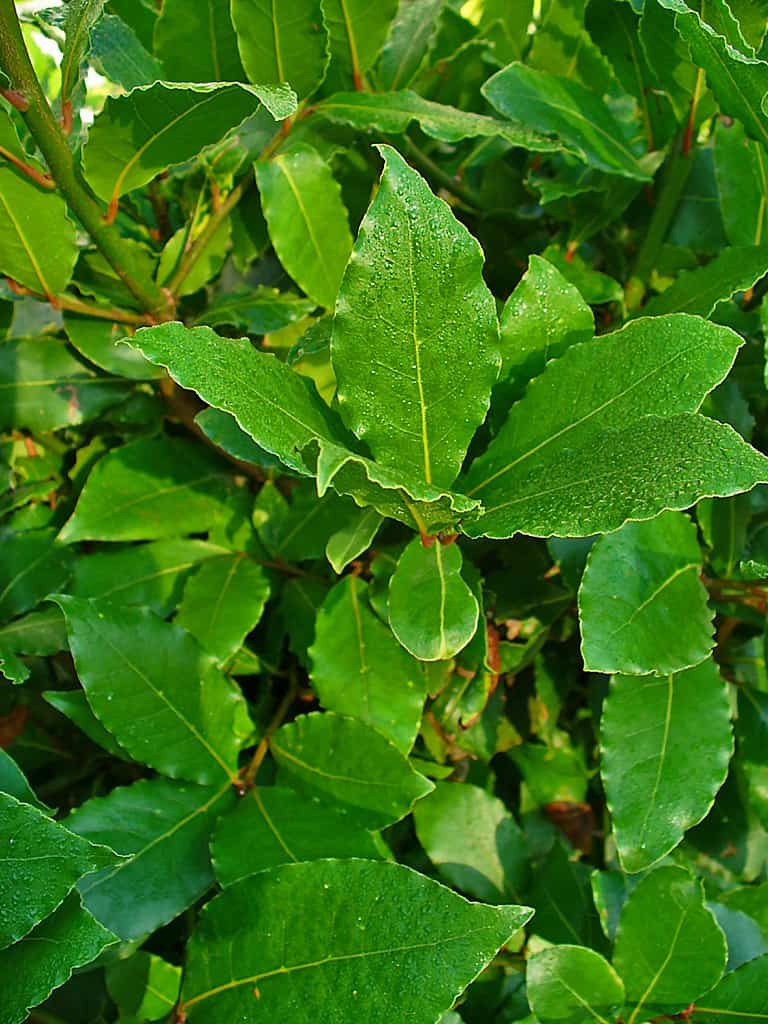
The bay laurel has a long lifespan and produces pale yellow-green blooms.
Ideal for the climate of South Carolina, the bay laurel has been cherished around the Mediterranean since the days of the Romans. This evergreen can be both a shrub and a small tree, showcasing a compact, pyramid-like shape. Known for its fragrant, sleek leaves that stretch up to 4 inches, these leaves remain colorful throughout the year. With its long lifespan, the bay laurel is versatile; it can be shaped for topiaries or used as hedging, and it’s a must-have for herb gardens.
When spring rolls around, the tree produces modest pale yellow-green flowers that gather in tight clusters. These blooms make way for shiny, deep purple-black berries on the female trees.
A recipient of the esteemed Award of Garden Merit from the Royal Horticultural Society, this tree can reach anywhere between 12 to 40 feet in both height and spread.
For best results, choose a spot with either full sunlight or partial shade and provide rich, moist soil that drains well. Additionally, it’s resilient against salt spray, making it a good choice for coastal areas.
11. Tulip Tree (Liriodendron tulipifera)
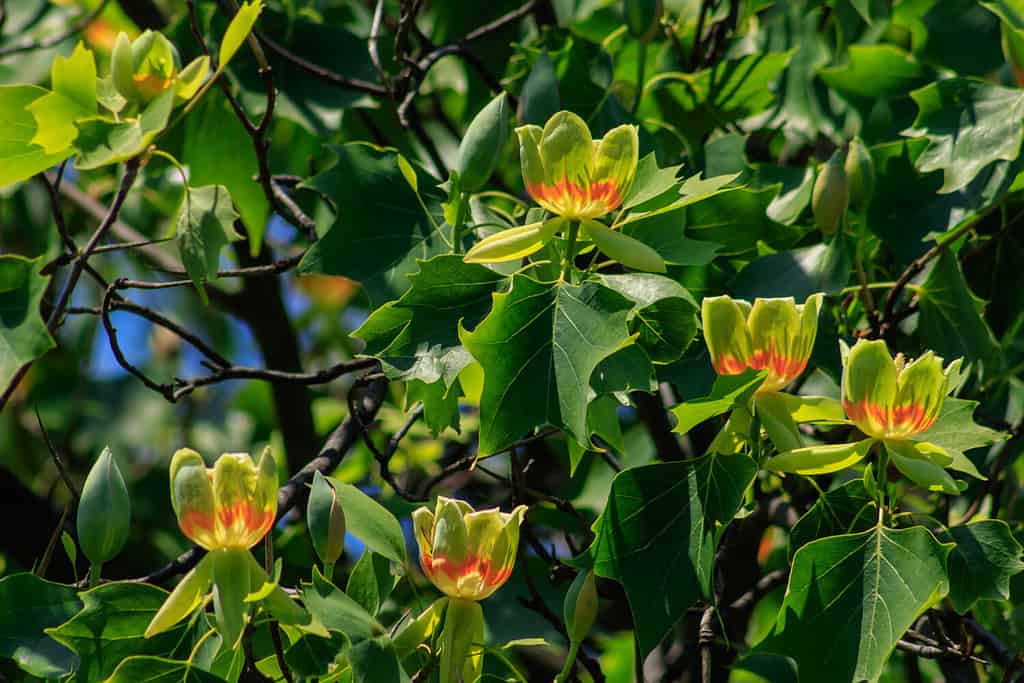
The tulip tree boasts beautiful yellow-green flowers.
©Yanosh Nemesh/Shutterstock.com
Standing tall and regal, the tulip tree boasts a pyramid-like shape in its youth, which gracefully transforms into an oval form as it matures. During the cusp of spring and the early days of summer, mature trees, generally those over 12 years old, unfurl their unique yellowish-green blooms. These flowers, reminiscent of tulips, are about 3 inches wide and are accentuated with an orange base on each petal.
With its ability to provide ample shade and its striking appearance, the tulip tree is an excellent choice as a centerpiece for vast landscapes. Birds often choose this tree as their nesting spot, and its flowers are a magnet for hummingbirds. This tree is also honored as the state tree of Tennessee, Indiana, and Kentucky.
Having been recognized with the Award of Garden Merit by the Royal Horticultural Society, the tulip tree can grow impressively tall, reaching between 60 to 80 feet, with a width spanning 30 to 40 feet. While planting, pick a sunny spot and ensure the soil is rich in organic matter, slightly acidic, and drains well.
12. Jerusalem Thorn (Parkinsonia aculeata)
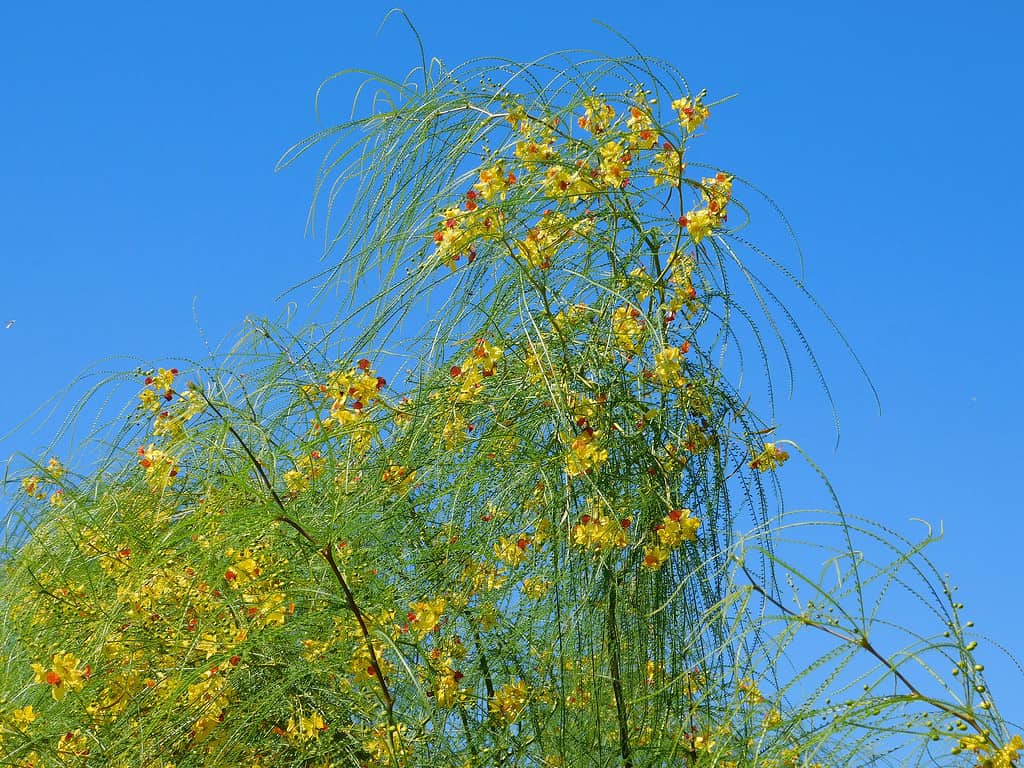
The Jerusalem thorn is a flowering tree that thrives in South Carolina.
©Konstantinos Livadas/ via Getty Images
Distinguished by its unique green bark and extended flowering period, the Jerusalem thorn is a delicate, flowering tree perfect for South Carolina gardens. Its slender, slightly curving branches are adorned with tiny, vibrant green leaves and clusters of striking yellow blooms. These radiant flowers, marked with hints of orange, generously drape the tree during warm months, especially after rainfall. Rich in sweetness, these blossoms are a magnet for bees and various other insects and pollinators. With a lifespan that can stretch up to 150 years, the Jerusalem thorn grows rapidly and is resilient to drought, salt, and high temperatures, making it a splendid choice for gardens in South Carolina.
This tree can reach heights of 15 to 20 feet and spread outwards to about 20 to 25 feet. In a year, it can grow around 2 to 3 feet.
The Jerusalem thorn loves full sun and thrives in a range of soils, from clay to loamy or sandy, as long as it’s well drained and ranges from neutral to alkaline.
13. Southern Magnolia (Magnolia grandiflora)

The southern magnolia is a beautiful flowering tree to plant in South Carolina.
©Nahhana/Shutterstock.com
With its grand stature, the southern magnolia stands as a majestic evergreen tree, characterized by a straight trunk and a broad, rounded canopy. It boasts large, intoxicatingly scented, creamy-white flowers that span up to 8 inches, gracefully adorning the tree from late spring through fall. These blossoms uniquely unfold in the daylight and fold back as evening approaches.
Originally from the southeastern parts of the United States, including South Carolina, this flowering tree grows at a fairly fast pace and generally remains unbothered by pests. With a long life ahead, its evergreen nature combined with its fragrant blooms makes it a cherished decorative and shade tree, not just in its native region but also in other temperate to subtropical areas worldwide.
The dried leaves, known for their lasting beauty, are often a florist’s favorite for arrangements.
This tree can tower up to 60 to 80 feet and spread 30 to 50 feet wide. When considering a spot for planting, opt for areas with full sun to partial shade. It thrives best in moist soils enriched with organic matter, leaning more towards neutral to slightly acidic conditions.
Summary of Gorgeous Flowering Trees That Thrive in South Carolina
| Number | Flowering Tree | Botanical Name | USDA Hardiness Zones |
|---|---|---|---|
| 1 | Leatherleaf Acacia | Acacia craspedocarpa | 8 to 11 |
| 2 | Coral Bark Maple | Acer palmatum ‘Sango-kaku’ | 5 to 9 |
| 3 | Strawberry Tree | Arbutus unedo | 7 to 10 |
| 4 | Eastern Redbud | Cercis canadensis | 4 to 9 |
| 5 | Cornelian Cherry | Cornus mas | 5 to 8 |
| 6 | Island Tree Poppy | Dendromecon harfordii | 8 to 10 |
| 7 | California Flannelbush | Fremontodendron californicum | 8 to 10 |
| 8 | Chinese Witch Hazel | Hamamelis mollis | 5 to 8 |
| 9 | Chinese Flame Tree | Koelreuteria bipinnata | 7 to 9 |
| 10 | Bay Laurel | Laurus nobilis | 7-9 |
| 11 | Tulip Tree | Liriodendron tulipifera | 4-9 |
| 12 | Jerusalem Thorn | Parkinsonia aculeata | 8-11 |
| 13 | Southern Magnolia | Magnolia grandiflora | 7-10 |
The photo featured at the top of this post is © Sundry Photography/ via Getty Images
Thank you for reading! Have some feedback for us? Contact the AZ Animals editorial team.







